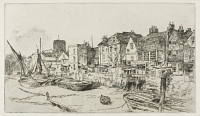The 'Adam and Eve', Old Chelsea | ||
| Number: | 182 | |
| Date: | 1878 | |
| Medium: | etching and drypoint | |
| Size: | 175 x 302 mm | |
| Signed: | butterfly at upper left (3) | |
| Inscribed: | no | |
| Set/Publication: | Hogarth and Son, 1879. | |
| No. of States: | 3 | |
| Known impressions: | 92 | |
| Catalogues: | K.175; M.172; W.144 | |
| Impressions taken from this plate (92) | ||
TECHNIQUE
This is mainly etching, with drypoint used to add emphasis in the foreground, and delicate sky effects in the background. Lochnan comments:
'In "the Adam and Eve", Old Chelsea he suggested light by means of shadow, and the whole by drawing a part. ...
Whistler's concern was not so much to express the physical nature of the structure but to create a feeling of air and atmosphere, and a composition based on oriental principles of balance and placement. In this work the eye is no longer drawn to a specific area of the composition; instead it is drawn to different areas wherever details congregate. By drawing only the shadow and the light within the shadow, Whistler created a new sense of aerial perspective which is not found in the etchings of 1859.' 19
19: Lochnan 1984, p. 178.
PRINTING
Early impressions were printed in black ink on medium weight 'antique' (pre-1800) laid paper with Arms of Amsterdam watermark ( ); buff laid with a countermark, possibly 'ID' (
); buff laid with a countermark, possibly 'ID' ( ); cream laid paper removed from a book with an old Latin inscription in brown ink on the verso (
); cream laid paper removed from a book with an old Latin inscription in brown ink on the verso ( ); off-white paper from a ledger (
); off-white paper from a ledger ( ); and off-white Japanese paper (
); and off-white Japanese paper ( ,
,  ).
).
 ); buff laid with a countermark, possibly 'ID' (
); buff laid with a countermark, possibly 'ID' ( ); cream laid paper removed from a book with an old Latin inscription in brown ink on the verso (
); cream laid paper removed from a book with an old Latin inscription in brown ink on the verso ( ); off-white paper from a ledger (
); off-white paper from a ledger ( ); and off-white Japanese paper (
); and off-white Japanese paper ( ,
,  ).
).It is possible that Peter J. Platt, a copper plate printer from New York, printed impressions from the plate (which is inscribed with his name) in the period after 1905.
